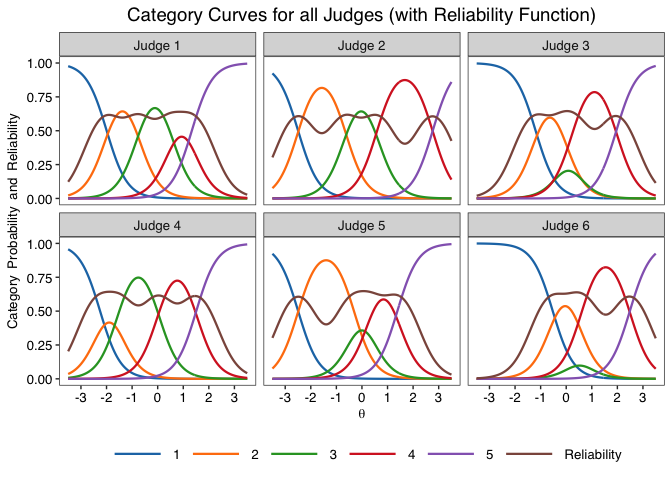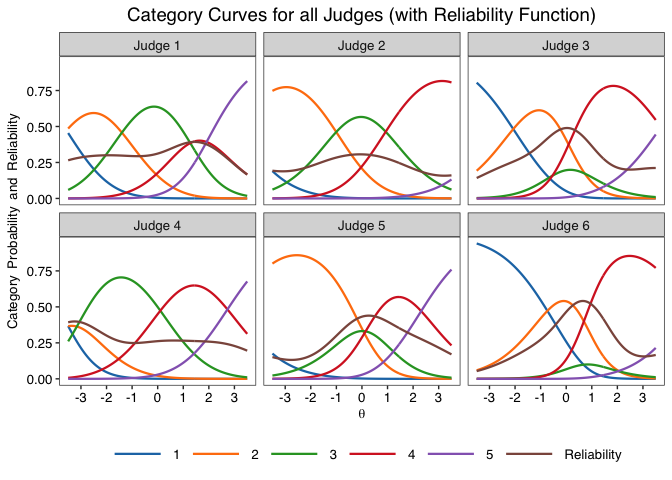Description
Item Response Theory Modeling and Scoring for Judgment Data.
Description
Psychometric analysis and scoring of judgment data using polytomous Item-Response Theory (IRT) models, as described in Myszkowski and Storme (2019) <doi:10.1037/aca0000225> and Myszkowski (2021) <doi:10.1037/aca0000287>. A function is used to automatically compare and select models, as well as to present a variety of model-based statistics. Plotting functions are used to present category curves, as well as information, reliability and standard error functions.
README.md
jrt
The goal of jrt is to provide tools to use Item-Response Theory (IRT) models on judgment data, especially in the context of the Consensual Assessment Technique, as presented in Myszkowski (2021).
- Myszkowski, N. (2021). Development of the R library “jrt”: Automated item response theory procedures for judgment data and their application with the consensual assessment technique. Psychology of Aesthetics, Creativity, and the Arts, 15(3), 426-438. http://dx.doi.org/10.1037/aca0000287
Installation
You can install the released version of jrt from CRAN with:
install.packages("jrt")
Example use
- Load the library
library(jrt)
#> Loading required package: directlabels
- Load example dataset
data <- jrt::ratings
- To automatically select models
fit <- jrt(data, progress.bar = F)
#> The possible responses detected are: 1-2-3-4-5
#>
#> -== Model Selection (6 judges) ==-
#> AIC for Rating Scale Model: 4414.163 | Model weight: 0.000
#> AIC for Generalized Rating Scale Model: 4368.776 | Model weight: 0.000
#> AIC for Partial Credit Model: 4022.956 | Model weight: 0.000
#> AIC for Generalized Partial Credit Model: 4014.652 | Model weight: 0.000
#> AIC for Constrained Graded Rating Scale Model: 4399.791 | Model weight: 0.000
#> AIC for Graded Rating Scale Model: 4308.616 | Model weight: 0.000
#> AIC for Constrained Graded Response Model: 3999.248 | Model weight: 0.673
#> AIC for Graded Response Model: 4000.689 | Model weight: 0.327
#> -> The best fitting model is the Constrained Graded Response Model.
#>
#> -== General Summary ==-
#> - 6 Judges
#> - 300 Products
#> - 5 response categories (1-2-3-4-5)
#> - Mean judgment = 2.977 | SD = 0.862
#>
#> -== IRT Summary ==-
#> - Model: Constrained (equal slopes) Graded Response Model (Samejima, 1969) | doi: 10.1007/BF03372160
#> - Estimation package: mirt (Chalmers, 2012) | doi: 10.18637/jss.v048.i06
#> - Estimation algorithm: Expectation-Maximization (EM; Bock & Atkin, 1981) | doi: 10.1007/BF02293801
#> - Method of factor scoring: Expected A Posteriori (EAP)
#> - AIC = 3999.248 | AICc = 4003.993 | BIC = 4091.843 | SABIC = 3999.248
#>
#> -== Model-based reliability ==-
#> - Empirical reliability | Average in the sample: .893
#> - Expected reliability | Assumes a Normal(0,1) prior density: .894


- To select models a priori
fit <- jrt(data, irt.model = "PCM")
#> The possible responses detected are: 1-2-3-4-5
#>
#> -== General Summary ==-
#> - 6 Judges
#> - 300 Products
#> - 5 response categories (1-2-3-4-5)
#> - Mean judgment = 2.977 | SD = 0.862
#>
#> -== IRT Summary ==-
#> - Model: Partial Credit Model (Masters, 1982) | doi: 10.1007/BF02296272
#> - Estimation package: mirt (Chalmers, 2012) | doi: 10.18637/jss.v048.i06
#> - Estimation algorithm: Expectation-Maximization (EM; Bock & Atkin, 1981) | doi: 10.1007/BF02293801
#> - Method of factor scoring: Expected A Posteriori (EAP)
#> - AIC = 4022.956 | AICc = 4027.701 | BIC = 4115.551 | SABIC = 4022.956
#>
#> -== Model-based reliability ==-
#> - Empirical reliability | Average in the sample: .889
#> - Expected reliability | Assumes a Normal(0,1) prior density: .759


- To plot all category curves
jcc.plot(fit)

- To plot on judge’s category curves
jcc.plot(fit, judge = 1)

- Graphical options
jcc.plot(fit, judge = 1, overlay.reliability = T, greyscale = T, theme = "classic")

- To plot total information
info.plot(fit)

- To plot judge information
info.plot(fit, judge = 1)

- Other options for information plots
info.plot(fit, type = "Reliability",
y.line = .70,
y.limits = c(0,1),
theta.span = 4,
theme = "classic")
